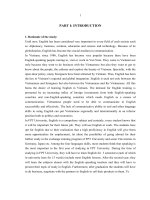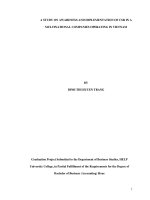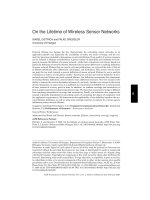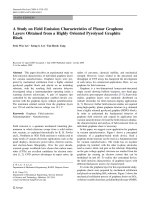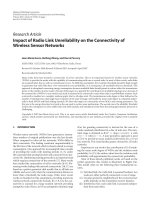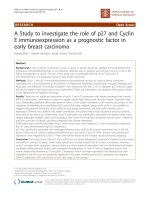A study on maximizing the lifetime of wireless sensor networks
Bạn đang xem bản rút gọn của tài liệu. Xem và tải ngay bản đầy đủ của tài liệu tại đây (3.94 MB, 100 trang )
國立高雄應用科技大學
電子工程系博士班
博士論文
最大化無線感測網路壽命之研究
A Study on Maximizing the Lifetime of
Wireless Sensor Networks
研 究 生:范文忠 (Van-Trung Pham)
指導教授:劉炳宏 (Bing-Hong Liu)
中 華 民 國 一百零四 年 七 月
最大化無線感測網路壽命之研究
A Study on Maximizing the Lifetime of
Wireless Sensor Networks
研 究 生:范文忠 (Van-Trung Pham)
指導教授:劉炳宏 (Bing-Hong Liu)
國立高雄應用科技大學
電子工程系博士班
博士論文
A Thesis
submitted to
Institute of Electronic Engineering
National Kaohsiung University of Applied Sciences
in Partial Fulfillment of the Requirements
for the Degree of
PhD. of Engineering
in
Electronic Engineering
July 2015
Kaohsiung, Taiwan, Republic of China
中 華 民 國 一百零四 年 七 月
Declaration of Authorship
I, Van-Trung Pham, declare that this thesis titled, ‘A Study on Maximizing the
Lifetime of Wireless Sensor Networks’ and the work presented in it are my own. I
confirm that:
This work was done for a research degree at KUAS by me under the guidance
of my supervisor.
This work has not been submitted to any other Institute for any degree or
diploma.
I have consulted the published work of others, this is always clearly attributed.
I have acknowledged all main sources.
The thesis is based on work done by myself jointly with others, I have made
clear exactly what was done by others and what I have contributed myself.
Signed:
Date:
Van-Trung
i
最大化無線感測網路壽命之研究
指導教授:劉炳宏 博士
研 究 生: 范文忠
國立高雄應用科技大學電子工程系博士班
摘要
無線感測網路是由許多佈置在廣大區域的無線感測器所組成,無線感
測網路能夠用於收集、處理和儲存環境資訊。由於許多需要被監控的環境
或是目標物較難接近,像是災區、火山、戰爭的區域。如果對這些區域內
的感測器進行充電或是重新部署,成本是相當高的,因此,如何延長無線
感測網路壽命是相當重要的議題。
本論文主要著重在研究最大化無線感測網路壽命方法,為了能在這個
問題上取得進展,本論文針對兩個議題提出研究。在第一個議題中,我
們研究在不同時間下使用不同的資料匯集樹以延長網路壽命,在此網路
中,資料可以透過資料匯集函式來匯集,如 MAX, MIN, COUNT,
SUM。在此提出應用於無線感測網路的最大化網路壽命資料匯集樹排程
方法,此方法為根據距離匯集點 k-hop 的區域資訊來建造適用於不同時間
的資料匯集樹,在建造資料匯集樹時,在匯集點 k-hop 內的樹路徑可以根
據網路壽命和感測器所收集到的資料進行重建。
在另一個議題中,我們著重在使用骨幹結構來傳送資料到匯集點以最
大化雙頻無線感測網路壽命,在雙頻無線感測網路中,每個感測器可以使
用雙頻無線電傳送資料,即小範圍無線電傳送及大範圍無線電傳送。我們
在此提出應用於雙頻無線感測網路的骨幹網路建構演算法,在骨幹網路中
的節點使用小範圍無線電或大範圍無線電傳送來維護骨幹網路,其餘非骨
幹節點則使用小範圍無線電以連結骨幹網路,此外,我們提出虛擬骨幹網
路排程方法,可以讓不同的骨幹網路交替使用以延長網路壽命。
關鍵詞: 無線感測網路, 虛擬骨幹, 網路壽命, 資料匯集, NP困難
A Study on Maximizing the Lifetime of Wireless Sensor Networks
Author: Van-Trung Pham
Supervisor: Dr. Bing-Hong Liu
Institute of Electronic Engineering
National Kaohsiung University of Applied Sciences
ABSTRACT
Wireless sensor networks are composed of many wireless sensors deployed
in a wide range of areas to collect, process, and store environmental information. Because many environments or objects that need to be monitored
are difficult to approach, such as disaster areas, volcanos, and battle fields,
charging batteries of sensors or redeploying sensors is costly. Therefore,
prolonging the lifetime of wireless sensor networks is an important issue.
This thesis focuses on the proposal of solutions for maximizing the lifetime of wireless sensor networks. For making progress on these issues, there
are two novel issues proposed in this thesis. In the first issue, we study the
problem of constructing data aggregation trees for different time to maximize the network lifetime. In which, the data is aggregated to the nodes
in a tree by some aggregated data functions, such as MAX, MIN, COUNT,
and SUM. In addition, the scheduling of data aggregation trees for maximizing the lifetime of wireless sensor networks is proposed. In which, the
k-hop local information to the sink is used to construct data aggregation
trees for different time. While constructing a data aggregation tree, the tree
topology within the k-hop of the sink is reconstructed by the lifetime and
the collected data of sensors.
iv
In the other issue, we focus on maximizing the lifetime of dual-radio
wireless sensor network by using a backbone structure that is used to transmit aggregated data to sink. In the dual-radio wireless sensor network, every
sensor is assumed to have dual radios, that is, small-range radio and largerange radio. We then propose an algorithm to construct a backbone in dualradio wireless sensor networks, where the backbone nodes use small-range
radio or large-range radio to maintain the backbone, and the rest nodes use
small-range radio to connect to the backbone. In addition, a scheduling
for constructing virtual backbones is proposed such that the constructed
backbones can work sequentially to prolong the network lifetime.
Keywords: Wireless sensor network, virtual backbone, network lifetime,
data aggregation, NP-Hard
Acknowledgements
First at all, I wish to express my sincere thanks to my advisor, Dr. Bing-Hong
Liu, Associate Professor, National Kaohsiung University of Applied Sciences, Taiwan, for his earnest guidance and support throughout the course of this research.
He give me the moral support, persistent encouragement and perpetual ideas. His
depth of knowledge and enthusiasm for research has inspired me a lot during 4
years in KUAS.
I would like to thank all members of Wireless Networking and Distributed
Computing Lab for their helping to finish this work. More generally, the opportunity to work with the members of Wireless Networking and Distributed Computing
Lab has helped me increase my knowledge of the Wireless Sensor Network field.
I would like to thank National Kaohsiung University of Applied Sciences and
Institute of Electronic Engineering, for providing me with a precious scholarship
and resources for me to concentrate on pursuing a PhD. In additon, I would thank
all the professors of Department of Electronic Engineering for taking a course with
them and gain knowledge and gaining a style of teaching from them during the
period of my researching in KUAS.
I would like to thank Pham Van Dong University and Faculty of Information
Technology, for believing in me and giving me the support to come to KUAS to
finish my doctor degree.
In addition, I would like to thank my friends, who are studying in KUAS, for
their encouragement and help me quite a lot in sharing the problems occurred in
my life during four years in KUAS.
Finally, I would like to thank my parents and the members in my family, for
everything that they have given me too much. Especially, I would like to thank
my wife for understanding, sacrifices and take care our babies while I studied in
KUAS.
v
Contents
Declaration of Authorship
i
摘要
ii
Abstract
iii
Acknowledgements
v
Contents
vi
List of Figures
viii
Abbreviations
x
1 Introduction
1.1 Literature Survey and Motivation . . . . . . . . . . . . . . . . .
1.2 Contributions of the thesis . . . . . . . . . . . . . . . . . . . . .
1.2.1 Constructing Virtual Data Aggregation Trees Scheduling
1.2.2 Construct Virtual Backbone Scheduling . . . . . . . . . .
1.3 Organization of the thesis . . . . . . . . . . . . . . . . . . . . .
.
.
.
.
.
.
.
.
.
.
1
3
7
7
8
8
2 Background
2.1 An overview of Wireless Sensor network . . . . . .
2.2 Specific Issues in Wireless Sensor Network Systems
2.2.1 The problem of Duty cycle scheduling . . . .
2.2.2 The problem of Data aggregation . . . . . .
2.2.3 Maximum lifetime problem in WSNs . . . .
2.2.4 Coverage problem in WSNs . . . . . . . . .
2.3 Summary . . . . . . . . . . . . . . . . . . . . . . .
.
.
.
.
.
.
.
.
.
.
.
.
.
.
10
10
14
14
15
16
16
17
.
.
.
.
.
.
.
.
.
.
.
.
.
.
.
.
.
.
.
.
.
.
.
.
.
.
.
.
.
.
.
.
.
.
.
.
.
.
.
.
.
.
.
.
.
.
.
.
.
3 On Maximizing the Lifetime for Data Aggregation in Wireless
Sensor Network Using Virtual Data Aggregation Trees
18
3.1 Problem Definition and Its Hardness . . . . . . . . . . . . . . . . . 20
3.1.1 Network Model . . . . . . . . . . . . . . . . . . . . . . . . . 21
vi
Contents
3.1.2
3.1.3
3.2
3.3
3.4
3.5
Data Aggregation Tree . . . . . . . . . . . . . . . . . . . .
The Maximum Lifetime Data Aggregation Tree Scheduling
Problem and Its Hardness . . . . . . . . . . . . . . . . . .
Local-Tree-Reconstruction-Based Scheduling Algorithm . . . . . .
3.2.1 Distributed Construction of a Shortest Path Tree . . . . .
3.2.2 Local-Tree-Reconstruction Algorithm . . . . . . . . . . . .
3.2.3 The Proposed Scheduling Algorithm . . . . . . . . . . . .
The Correctness and the Time Complexity of the LTRA . . . . .
Performance Evaluation . . . . . . . . . . . . . . . . . . . . . . .
3.4.1 Uniform and Non-uniform Energy . . . . . . . . . . . . . .
3.4.2 Aggregation Ratio . . . . . . . . . . . . . . . . . . . . . .
3.4.3 Number of Relay Nodes . . . . . . . . . . . . . . . . . . .
3.4.4 The Number of Units of Raw Data Generated by Sources .
3.4.5 Field Size . . . . . . . . . . . . . . . . . . . . . . . . . . .
Summary . . . . . . . . . . . . . . . . . . . . . . . . . . . . . . .
vii
. 22
.
.
.
.
.
.
.
.
.
.
.
.
.
25
31
32
33
39
40
43
44
45
46
46
47
48
4 An Efficient Algorithm of Constructing Virtual Backbone Scheduling for Maximizing the Lifetime of Dual-Radio Wireless Sensor
Networks
50
4.1 Network model and problem definition . . . . . . . . . . . . . . . . 51
4.1.1 Network model . . . . . . . . . . . . . . . . . . . . . . . . . 51
4.1.2 Problem Definition and Its Hardness . . . . . . . . . . . . . 55
4.2 The Dominating-Set-Based Algorithm (DSBA) . . . . . . . . . . . . 56
4.2.1 Construction of Dominating Set . . . . . . . . . . . . . . . . 57
4.2.2 Establishment of Backbone . . . . . . . . . . . . . . . . . . 60
4.2.3 Refinement of Backbone . . . . . . . . . . . . . . . . . . . . 63
4.3 Analysis of the DSBA . . . . . . . . . . . . . . . . . . . . . . . . . 65
4.4 Performance Evaluation . . . . . . . . . . . . . . . . . . . . . . . . 69
4.4.1 Network Lifetime . . . . . . . . . . . . . . . . . . . . . . . . 70
4.4.2 Size of Virtual Backbone . . . . . . . . . . . . . . . . . . . . 72
4.4.3 Residual Energy . . . . . . . . . . . . . . . . . . . . . . . . . 73
4.5 Summary . . . . . . . . . . . . . . . . . . . . . . . . . . . . . . . . 75
5 Conclusions
77
5.1 Contributions . . . . . . . . . . . . . . . . . . . . . . . . . . . . . . 77
5.2 Future directions . . . . . . . . . . . . . . . . . . . . . . . . . . . . 79
Bibliography
80
List of Figures
1.1
Example of a Wireless sensor network . . . . . . . . . . . . . . . . .
2.1
Four basic components of the sensor node . . . . . . . . . . . . . . 12
3.1
Example of the network lifetime while using virtual data aggregation trees. (a) and (b) show the data aggregation trees T1 and T2 ,
respectively. . . . . . . . . . . . . . . . . . . . . . . . . . . . . . .
Example of a connected weighted graph and data aggregation trees.
(a) shows a connected graph G = (VG , EG , wG , ρG ), where the left
number and the right number in parentheses represent the corresponding energy power and number of units of generated raw data,
respectively. (b) and (c) show two data aggregation trees T1 and
T2 , respectively. . . . . . . . . . . . . . . . . . . . . . . . . . . . .
Example of virtual data aggregation trees in the network. (a) shows
a data aggregation tree T1 with lifetime equal to 4. (b) shows the
residual energy power of nodes after four working rounds. (c) shows
another data aggregation tree T2 with lifetime equal to 1. (d) shows
the residual energy power of nodes after two working rounds. . . .
Example of the reduction from the X3C problem to the MLDATS
problem. (a) shows the corresponding instance of the MLDATS
problem while given the instance of the X3C problem, including
X = {1, 2, 3, 4, 5, 6} and C = {C1 , C2 , C3 }, where C1 = {1, 3, 5},
C2 = {2, 4, 6}, and C3 = {1, 2, 3}. (b) shows a data aggregation
tree T in the graph shown in (a). . . . . . . . . . . . . . . . . . .
The lifetime of networks whose number of sensors ranging from 100
to 1000. The initial energies of the sensors are uniform in (a) and
non-uniform in (b). . . . . . . . . . . . . . . . . . . . . . . . . . .
The lifetime of networks that have aggregation ratio α ranging from
1 to 5. . . . . . . . . . . . . . . . . . . . . . . . . . . . . . . . . .
The lifetime of networks that have relay nodes ranging from 50 to
250. . . . . . . . . . . . . . . . . . . . . . . . . . . . . . . . . . .
The lifetime of networks that have β ranging from 10 to 50. . . .
The lifetime of networks whose field size ranges from 10 × 10 to
50 × 50. . . . . . . . . . . . . . . . . . . . . . . . . . . . . . . . .
3.2
3.3
3.4
3.5
3.6
3.7
3.8
3.9
viii
2
. 19
. 20
. 26
. 28
. 45
. 46
. 47
. 47
. 48
List of Figures
4.1
4.2
4.3
4.4
4.5
4.6
4.7
Example of dual-radio wireless sensor networks, where the number
close to a node denotes the node’s energy. (a) The network topology
G1 (VG1 , EG1 , wG1 ) formed by the nodes using small-range radios.
(b) The network topology G2 (VG2 , EG2 , wG2 ) formed by the nodes
each using large-range or small-range radio. . . . . . . . . . . . .
An example of reducing the energy consumption of backbone nodes.
(a) Nodes u, v, x, and y use a large-range radio in the backbone. (b)
Node v uses a small-range radio, and the others use a large-range
radio in the backbone. . . . . . . . . . . . . . . . . . . . . . . . .
An example of pruning redundant backbone nodes. (a) The network
has a redundant backbone node v. (b) Node v is pruned from the
backbone shown in (a). . . . . . . . . . . . . . . . . . . . . . . . .
The network lifetime versus the number of network nodes ranging
from 50 to 500. The initial energies of nodes in the networks are
400 in (a) and randomly chosen from the interval [0, 400] in (b),
respectively. . . . . . . . . . . . . . . . . . . . . . . . . . . . . . .
The network lifetime versus β, where the backbone nodes using a
large-range radio (or small-range radio) consume β (or 1) energy
power for one working cycle, the network has 500 nodes and the
initial energy of nodes in the networks is 400. . . . . . . . . . . .
The average size of virtual backbones versus the number of network
nodes ranging from 50 to 500. The initial energies of nodes in
the networks are 400 in (a) and randomly chosen from the interval
[0, 400] in (b), respectively. . . . . . . . . . . . . . . . . . . . . . .
The average residual energy of all nodes in the networks versus
the number of network nodes ranging from 50 to 500. The initial
energies of nodes in the networks are 400 in (a) and randomly chosen
from the interval [0, 400] in (b), respectively. . . . . . . . . . . . .
ix
. 52
. 64
. 64
. 71
. 73
. 74
. 74
Abbreviations
DBA
Distributed Backbone Algorithm
DDSA
Distributed Dominating Set Algorithm
DSBA
Dominating-Set-Based Algorithm
LTRA
Local-Tree-Reconstruction Algorithm
LTRBSA
Local-Tree-Reconstruction-Based Scheduling Algorithm
MLDATS
Maximum Lifetime Data Aggregation Tree Scheduling
MLTS
Maximum Lifetime data aggregation Tree Scheduling
NP
Non-deterministic Polynomial-time
STG
Schedule Transition Graph
X3C
Exact Cover by 3-Sets
WSN
Wireless Sensor Network
x
Chapter 1
Introduction
Wireless sensor networks are composed of many wireless sensors deployed in
a wide range of areas, where each sensor is able to communicate with others
through inter-sensor wireless communication. Recently, many applications
of wireless sensor networks have been developed, such as, environmental
monitoring, animal tracking, surveillance, endangered species protection,
fire detection and seismic monitoring [1–3]. The most importance operation
in these applications in WSNs is data aggregation, to collect sensing data
from the sensor nodes and periodically report to a specific node, called
a sink. Fig. 1.1 shows the an illustration of a Wireless sensor network
including some sensor nodes and one sink node.
Because of the requirement of applications, wireless sensor network can
be constructed in two different manners, that is, the static wireless sensor
network and mobile wireless sensor network. In the type of static wireless
sensor network, the sensor nodes are deployed at fixed position in the field
area network and can form a steady routing structure to transmit their
sense data to sink. Because of static of network topology, the cooperation
mechanism of sensor nodes in the network should be simple, implemented by
1
Chapter 1. Introduction
sensor node
2
sink node
radio range
network edge
Figure 1.1: Example of a Wireless sensor network
low complexity algorithm requiring little space for data storage, thus saving
energy resources. However, the static network structure is not suitable for
some applications. For example, in situations where the sensor nodes need to
be attached directly to moving objects, such as, animal tracking, cell-phones,
vehicles in urban areas. In the type of mobile wireless sensor network, which
composes the sensor nodes can move in the field area network. In this
model network, the communication between the nodes in the network is
quite unreliable because of the moving of sensor nodes. Hence, the routing
structure also is changed.
The most important component to construct a WSNs is the sensor nodes
which are capable of performing some processing, gathering sensory information and communicating with other connected nodes. The sensor nodes
are generally equipped with a radio transceiver, a micro controller, a memory unit, and a set of transducers using which it can acquire and process
data from the deployed regions [4]. Because the energy power of sensors is
Chapter 1. Introduction
3
limited, energy efficiency in wireless sensor networks is the major challenge
in the design of the network to enhance the network lifetime.
1.1
Literature Survey and Motivation
In this section, we present a brief survey of literature on the topics of interest to the thesis. The scope of survey is divided into the following areas
in bringing out the motivation of the thesis work: data gathering problem
in wireless sensor networks, clustering structure for data aggregation, tree
structure for data aggregation, backbone structure in wireless sensor network and problem of scheduling the backbones in wireless sensor networks.
This survey provides the motivation of the problems that have been worked
on in the thesis.
The data gathering is a well-known mechanism for collect sensing
data from sensors and reports to a specific node, called a sink. Because the
energy powers of sensors are limited, efficiently gathering data is a major
challenge in WSNs. Recently, researchers have studied efficiently gathering data when multiple data are allowed to be aggregated into one packet
[5, 6]. In [7], Madden et al. propose methods for improving the reliability
and performance of retrieving data via a tree when basic database aggregates, including min, max, sum, average, and count, are used with grouping. In [8], Kalpakis et al. propose scheduling methods based on admission
flow networks to maximize the network lifetime. In [9], Krishnamachari et
al. use the data aggregation tree to model data-centric routing to yield
energy-efficient dissemination. In [10], Wu et al. study the construction of
a data-gathering tree to maximize the network lifetime. In addition, Many
Chapter 1. Introduction
4
researchers have studied efficiently gathering data in WSNs when a fixed
number of data are allowed to be aggregated into one packet [11–13]. In
[11], Liu and Cao propose solutions to design a fault-tolerant and energyefficient distributed monitoring system in WSNs. In [12], Kuo and Tsai
propose methods of constructing data aggregation trees such that the total
energy cost for gathering data is minimized. In [13], Liu and Jhang propose
novel data aggregation and routing structures for gathering data. With the
structures, a distributed data scheduling algorithm is proposed to schedule
data to nodes such that the energy cost for gathering data is minimized,
when all data are aggregated at most once. However, minimizing the total
energy cost for gathering data does not imply that the network lifetime is
maximized.
Clustering structure for data aggregation is a well-known structure
for data aggregation in WSNs. In which, each cluster head collects data from
the corresponding cluster members. The data aggregated in the cluster
head is then sent to the sink. Recently, many data aggregation methods
are based on the clustering structure [14–16]. H. Chen et al. propose a
method to select the cluster heads to cover whole sensor network so that
total information transmitted through the sensor network is minimized [14].
In [15], Y. Liang et al. propose a novel clustering algorithm which better suit
the periodical data gathering applications to effectively reduce redundant
data transmission and the whole energy consumed in the network. In [16],
K. Dasgupta et al. propose an efficient clustering-based heuristic to solve
the data-gathering problem with aggregation in sensor networks such that
the system lifetime is maximized.
The tree for data aggregation is a common structure that leads the
Chapter 1. Introduction
5
data generated in WSNs to the sink. By using the tree structure, each node
in the tree is responsible for forwarding its generated data and the data
received from its child nodes to its parent node. In [17], Lee and Wong
propose an overlay tree structure to prolong the lifetime of sensors in the
network. In the tree, the nodes that have higher residual energy power
are selected as the parents to facilitate data collection. In addition, when
sensors are no longer functional or network links are broken, the tree can
be reconstructed by their proposed method. In [18], Luo et al. study the
problem of selecting a maximum lifetime tree from a set of shortest path
trees. In [19], Dasgupta et al. propose an approximation method that uses
intelligent selection of trees to solve the maximum lifetime data collection
problem in sensor networks. In [20], Wu et al. propose an approximation
algorithm of constructing a spanning tree to prolong the network lifetime
when a single sink exists. In these studies, the data is directly forwarded via
the tree without minimizing the size of the aggregated data, and therefore,
it spends lots of energy for data gathering.
The backbone structure is a well-known technique for various aspects
of wireless sensor networks, such as routing, multicasting, and broadcasting
[21, 22]. In the backbone technique, some nodes in the backbone always
turn on their radio to maintain the activation of the network, and the rest
of the nodes turn off their radio to save energy. Recently, many research
studies are mostly designed to minimize the size of the backbone to, therefore, reduce the energy consumption in the network. In [23], Zhang et al.
proposed an algorithm to construct a connected backbone in the wireless
sensor network such that the network achieves much higher throughput and
delivery ratio, and much lower end-to-end delay and routing distance. In
Chapter 1. Introduction
6
[22], an algorithm was proposed to construct a backbone in the wireless sensor network such that the cost of routing would be reduced. In [24], Chuang
et al. proposed a novel heuristic-based backbone algorithm, called SmartBone. In SmartBone, two steps are required to form a backbone to improve
energy saving in the network. The first step is to find backbone nodes by
the proposed flow-bottleneck preprocessing method, and the second step is
to reduce the number of redundant nodes by the proposed dynamic density cutback method. Recently, some researchers focused on prolonging the
network lifetime while using the backbone technique. The network lifetime
is often determined by the time span from when the network is active to
when one node in the backbone runs out of energy. In [25], Torkestani introduced an extended version of the connected dominating set problem for
modeling the energy-efficient backbone formation problem in wireless sensor
networks. In addition, an algorithm of constructing the network backbone
was proposed to maximize the lifetime.
Scheduling the backbones on WSNs which allows multiple backbones work for different time periods. Because the nodes in the backbone
are always active, their energy is depleted quickly so that the backbone is
easily broken. Therefore, to prolong the network lifetime, some researchers
studied scheduling nodes to become backbone nodes during some periods
of time and non-backbone nodes during other periods. In [26], Zhao et
al. studied the problem of finding multiple backbones and scheduling the
backbones to work for different time periods such that the network lifetime
would be maximized. Hereafter, the multiple backbones used for different
periods were called virtual backbones. The problem is shown to be NP-hard
in [26]. In addition, centralized algorithms are proposed to find and schedule
Chapter 1. Introduction
7
virtual backbones to maximize the network lifetime. However, centralized
algorithms are often not feasible in a wide range of wireless sensor networks
[27, 28].
1.2
Contributions of the thesis
1.2.1
Constructing Virtual Data Aggregation Trees Scheduling
The first main contribution of this thesis is the design of Virtual Data Aggregation Trees Scheduling for maximizing the lifetime of Wireless Sensor
Network. In this work, we study the problem of constructing data aggregation trees for different time to maximizing the network lifetime. In this
manner, we consider to the bottleneck nodes, which run out their energy
firstly in WSNs, to construct a reconstruction data aggregation tree algorithm to reduce the collected data at source node as bottleneck nodes to
prolong its lifetime and then to prolong the lifetime of the data aggregation
tree. We then present a maximum lifetime data aggregation tree scheduling
problem to increase the number of working rounds for the data aggregation in the network. The lifetime of schedule for the data aggregation tree
is denoted the lifetime of network. Based on the simulation, we illustrate
that our proposed solutions achieve the significantly prolong the network
lifetime.
Chapter 1. Introduction
1.2.2
8
Construct Virtual Backbone Scheduling
In the second contribution of this thesis, we design the Virtual backbone
scheduling for maximizing the lifetime of Wireless Sensor Network. In this
work, to maximize the network lifetime, we study the problem of scheduling
virtual backbones for a dual-radio wireless sensor network such that the network lifetime is maximized. This Maximum Lifetime Backbone Scheduling
for Dual-Radio Wireless Sensor Network problem occurs when each node
in the network is equipped with two radio interfaces, including small-range
radio and large-range radio. In addition, the nodes belong the backbone can
use small-range radio or large-range radio to maintain the backbone, the rest
of nodes use small-range radio to connect the backbone. Simulation results
show that the proposed algorithm outperforms some existing algorithms
1.3
Organization of the thesis
In addition to this introduction chapter, the thesis concludes 4 chapters and
is organized as following. In chapter 2, the fundamental background on the
wireless sensor network and the energy constraint issues is provided. In
addition, a review of related works with the energy constraint problem of
the sensor networks is presented. Through the discussion of related works,
the research’s objective, methodology and the originality of the schemes
investigated in this thesis are proposed.
In chapter 3, we study the problem of constructing data aggregation
trees for different time to maximizing the network lifetime, termed maximum lifetime data aggregation tree scheduling problem. An algorithm that
Chapter 1. Introduction
9
is based on the k-hop local information to the sink to construct data aggregation trees for different time is proposed.
In chapter 4, we study the problem of constructing virtual backbones
in dual-radio wireless sensor networks to maximize the network lifetime, a
distributed algorithm is then proposed for a wide range of wireless sensor
networks to find a backbone when a new one is required. The last chapter of
this thesis, we conclude this thesis and proposes directions for future works.
In chapter 5, we summary the results of this research work for the specific
problems considered in this thesis and the future directions.
Chapter 2
Background
This chapter provides an overview of important topics to understand the
work reported in this thesis. This overview aims to briefly present the main
concepts and ideas concerning them, highlighting those that have a relation
to the content of the work in this thesis, to ease the understanding of its
contribution. This chapter includes as following: An overview of Wireless
Sensor network, and Specific Issues in Wireless Sensor Networks.
2.1
An overview of Wireless Sensor network
Wireless sensor network (WSN) is a network system which is designed for
sensing and processing signals from the environment, such as temperature,
humidity and sound and transmitting the sensed data through wireless channels. Wireless sensor networks consist of many small compact devices that
form a wireless network. Each sensor node in the network is equipped with
sensors to collects information from its surroundings, and sends the sensing
data to a base station (sink) directly or via the immediate neighbor nodes.
The sink node in WSNs can be static or mobile. Depending on the WSN
10
Chapter 2. Background
11
application and the multiplicity of the requesting users, multiple sinks may
be present in the network. The purpose of the sink nodes is to provide an
interface between the WSN and another type of network from which the
end-user will be able to access the data acquired by the sensor nodes. The
first wireless network, namely the Sound Surveillance System (SOSUS), is
developed by the United States Military in the 1950s to detect and track
Soviet submarines [29]. This network used submerged acoustic sensors –
hydrophones – distributed in the Atlantic and Pacific oceans. Nowadays,
this sensing technology is still in service and develop with more peaceful
functions of monitoring undersea wildlife and volcanic activity.
The sensor node consists four basic components such as sensing unit,
transceiver unit, processing unit and power unit, which is showed as Fig.
2.1. The sensing unit uses to sense data from its surroundings and convert
the sensed data to digital signals, and then fed into the processing unit.
The processing unit is generally associated with a small storage unit and it
can manage the procedures that make the sensor node collaborate with the
other nodes to carry out the assigned sensing tasks. The transceiver unit
can connect the other node to transmit the sensed data together within the
fixed radio range. In addition, the power unit is one of the most important
components of a sensor node. This unit can be supported by a power scavenging unit and used to provide the energy to other units. Thereto, due
to each application, the sensor node is plug other subunits such as Global
Positioning System (GPS), camera, etc.
Nowadays, WSN is an important and exciting new technology with great
potential for improving almost applications such as medicine, transportation, agriculture, industrial process control, and the military. In addition,


